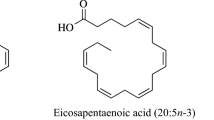Summary
Analytical methods and the results of the analysis of the lipids of commercially available canned supplementary foods for juniors are described.
Lipids were extracted, separated into polar and non-polar fractions and the components (triglycerides, monoglycerides, free fatty acids, cholesterol ester, and phospholipids) were then identified and estimated, by comparison with reference substances and by gas chromatography.
To determine the degree of unsaturation and positional distribution of the fatty acids, the triglycerides were hydrolyzed by pancreatic lipase to monoglycerides with the fatty acid in 2-position of glycerol, and the fatty acids and the monoglycerides were also separated by gas chromatography. Linoleic acid, 18.2ω6, was found as the predominant fatty acid in the 2-position of the triglycerides. The other fatty acids being distributed equally to all positions of glycerol with the exception of few minor fatty acids.
Fat contributed to 31 to 48 percent of the total energy supply of the analyzed items; linoleic acid providing 0.4 to 2.4 percent of this energy assuming that one can of these products is consumed daily.
Zusammenfassung
Die analytischen Methoden und die Ergebnisse der Analysen der Lipidbestandteile von käuflich erhältlicher Beikost für ältere Säuglinge und Kleinkinder werden beschrieben.
Die Lipide wurden mit Äthanol/Zyklohexan extrahiert, chromatographisch in polare und nichtpolare Fraktionen getrennt; die Fettklassen (Triglyzeride, Monoglyzeride, freie Fettsäuren, Cholesterinester und Phospholipide) wurden getrennt und durch Vergleich mit Referenzsubstanzen und durch Gaschromatographie identifiziert bzw. bestimmt.
Zur Bestimmung der Fettsäuren in der 2-Position der Triglyzeride wurden die Triglyzeride mit Pankreaslipase zu entsprechenden Monoglyzeriden hydrolysiert und die entstandenen Monoglyzeride gaschromatographisch getrennt. Die Linolsäure, 18.2ω6, wurde als vorherrschende Fettsäure in der 2-Position der Triglyzeride gefunden. Die anderen Fettsäuren wurden mit Ausnahme weniger gleichmäßig über die einzelnen Positionen verteilt.
Das Fett machte 31 bzw. 48% der Gesamtkalorien der untersuchten Präparate aus. Vorausgesetzt, daß ein Gläschen pro Tag gefüttert wird, werden dadurch 0,6 bis 2,4% der Energie in Form von Linolsäure zugeführt.
Similar content being viewed by others
References
Tomarelli RM, Meyer BJ, Weaber JR, Bernhard FW (1968) Effect of positional distribution on the absorption of fatty acids of human milk and infant formula. J Nutr 95:583–590
Filer JR Jr, Mattson FH, Fomon SJ (1969) Triglyceride configuration and fat absorption by the human infant. J Nutr 99:293–298
Mattson FH (1959) The absorbability of stearic acid when fed as a simple or mixed triglyceride. J Nutr 69:338–342
Stolley H, Kersting M, Droese W (1982) Energie- und Nährstoffbedarf von Kindern im Alter von 1–14 Jahren. Advances in Internal Medicine and Pediatrics. Vol 4:1–75, Springer Berlin Heidelberg
Diemair W, Schams E (1960) Gaschromatographie in der Lebensmittelanalytik. 1. Mitteilung, Bestimmung der niederen flüchtigen Fettsäuren in Lebensmitteln. Z Lebensm Unters Forsch 112:457–463
Kates M (1975) Techniques of Lipidology. North-Holland Publishing Company, Oxford, 398–401
Kuksis A, Myher JJ, Marai L, Geher K (1975) Determination of plasma lipid profiles by automated gas chromatography and computerized data analysis. J Chromatogr Sci 13:423–430
Luddy E, Barford RA, Herb SF, Magidman P, Riemenschneider RW (1964) Pancreatic lipase hydrolysis of triglycerides by semimicrotechnique. J Am Oil Chem Soc 41:693–696
Hadorn H, Jungkunz R (1951) Vergleichende Untersuchungen über die Fettbestimmungsmethode in Eikonserven. Z Lebensm Unters Forsch 93:277–286
Pardun H (1969) Analyse der Fette und Fettbegleitstoffe. In: Handbuch der Lebensmittelchemie. Springer Berlin, Band IV Fette und Lipide, 423–425
Mattson FH, Volpenheim RA (1962) Rearrangement of glyceride fatty acids during digestion and absorption. J Biol Chem 237:53–55
Author information
Authors and Affiliations
Rights and permissions
About this article
Cite this article
Suwelack, C., Laryea, M.D. & Bremer, H.J. Fatty acid and lipid composition of children's food. I. Analytical methods; composition of commercially available supplementary foods for juniors. Z Ernährungswiss 23, 263–275 (1984). https://doi.org/10.1007/BF02020639
Received:
Published:
Issue Date:
DOI: https://doi.org/10.1007/BF02020639




